Welcome to And the Quest for Pop Culture, where I explore various movies, TV shows, books, and comics. Looking for a different topic or original fiction? Check out the navigation page.
The cover of Detective Comics #27 boasts “64 Pages of Action!” Batman gets a mere six of those pages, but they evidently left enough of an impression to keep the character going. And he’s still going 86 years later.
The book credits only the artist, Bob Kane (“Rob’t Kane” here), though it was ghostwritten by Bill Finger. I recommend the documentary Batman & Bill for more about Batman’s co-creator. Finger died in poverty in 1974, and only in the past decade has he finally begun to receive proper credit for his enduring contributions to popular culture. Though Kane had the initial idea for Batman and produced memorable artwork, Finger fleshed out and refined the character. Without both Kane and Finger, we wouldn’t have Batman today.
A comic with Detective in the title should include mystery, and Batman’s debut certainly does. There’s a murder mystery, of course, but Batman himself is also a mystery. He’s an enigmatic figure who has only recently arrived on the scene and is already making a name for himself. A hyphenated name. Though the cover uses the familiar one-word version, he’s called the “BAT-MAN” throughout the story. Yes, with the quotes. (Perhaps scare quotes also strike fear into the hearts of superstitious, cowardly criminals.)
The exposition comes in later stories. Here, we don’t know what possesses this man to don such a distinctive outfit and investigate crime. At the beginning, we don’t even know who he is. The title panel raises this very question: “His identity remains unknown.”
As that intriguing hook sinks into the young reader, the comic introduces a pair of unlikely friends chatting and smoking tobacco.
Commissioner Gordon is entertaining a bored young socialite by the name of Bruce Wayne. Gordon expresses puzzlement over this mysterious “Bat-Man” until the phone interrupts him. A “chemical king” has been murdered in his own home—and the prints of the victim’s son are all over the knife!
Naturally, Gordon invites his civilian friend to join him at the homicide scene.
“Oh well, nothing else to do, might as well,” Bruce says, puffing his cigar.
At the victim’s home, the son adamantly denies the murder, and the names of three suspects materialize: Steven Crane, Paul Rogers, and Alfred Stryker, all former business associates of the victim. One of these men, Crane, calls the house at that very moment, fearing for his life.
At this point, Bruce excuses himself. The boring lunkhead wasn’t doing anything except taking up space, so good riddance.
Crane had good reason to worry—he’s killed on the same page! The murderer pulls a paper from a safe and sneaks out the window. He joins a partner on the roof, but then they meet … the “Bat-Man”!
The “Bat-Man” socks one and throws the other off the roof. The man lands on the sidewalk two stories below, which probably did some damage. The police show up and want to apprehend the “Bat-Man.” Throwing a man off a roof at the scene of a homicide is not a good look, as the kids say.
The “Bat-Man” gets away in his car. There’s no Bat-Mobile yet, just a bright red car. Hiding in plain sight—the mark of a clever vigilante.
In this, his first page of action, the “Bat-Man” says nothing. But he acquires a vital clue—the piece of paper the killer had stolen. As he reads it, “a grim smile comes to his face.”
Rogers, understandably worried, goes to see Stryker, but he encounters Stryker’s assistant, a man named Jennings. Jennings clubs Rogers over the head and places him in a deathtrap—a gas chamber used to kill guinea pigs.
As the chamber closes, the “Bat-Man” swoops in, grabs a wrench, and slips inside the deathtrap. (After all those deathtraps he’s faced over the years, let it be known he entered his first one entirely of his own volition.)
From within, he plugs the gas, unties the victim, and breaks free. He subdues Jennings while Stryker shows up and tries to finish the job his assistant started. A-ha! So Stryker was behind the murders all along. Of course! The clue was right in his name—Stryker!
The “Bat-Man” stops Stryker, and for the first time, he speaks, like Silent Bob suddenly launching into a monologue. In classic detective fashion, his first words explain his findings.
Stryker isn’t going down without a fight. He pulls a gun, but the “Bat-Man” punches him, sending him falling into an acid tank.
With this being only 1939, the acid doesn’t imbue Stryker with any special powers. It doesn’t disfigure him in any iconic way or transform him into a colorful crime boss. No, in 1939, an acid tank was just an acid tank. So he dies.
“A fitting end for his kind,” our hero says after having punched a man into an acid tank.
Back then, when “Bat” and “Man” were separated across the vast gulf of a hyphen, this crusader in a cape didn’t yet understand the importance of not killing criminals. He had much to learn.
He had learned a few tricks, though, such as his famous vanishing act. As Rogers turns around to thank the “Bat-Man,” he finds the masked man has slipped away unheard. But he remains visible in the distance, so perhaps he was still perfecting this bit.
In a brief denouement, that dullard Bruce Wayne visits Commissioner Gordon, and the narrator lets us in on a secret that not even Gordon knows.
Brace yourselves. This one’s a real stunner. It turns out Bruce Wayne is …
… the “Bat-Man!”
Did that twist surprise young readers 86 years ago, or did they guess it on the first page? I don’t know, but it’s a more dramatically interesting approach than being up front about who the “Bat-Man” is. The delayed reveal demonstrates that thought and care went into the storytelling.
That thought and care also come through in what’s not revealed. No origin story. No Batcave. No Alfred. No elaborate mythology. Finger and Kane don’t overload the reader with information. There will be time for that later—if they succeed with this story. So, they limit themselves to one murder mystery, one supporting character, and one memorable twist.
A six-page story doesn’t leave much room to make a lasting impression, even accounting for the smaller panel sizes of the era. But Finger and Kane pulled it off, hooking readers and launching a character that went on to entertain generations of fans.

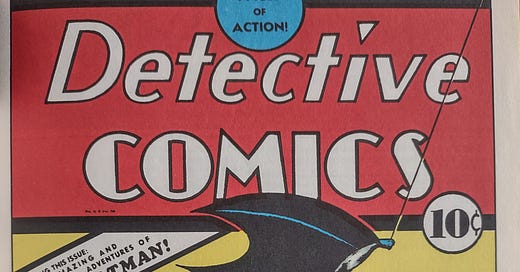



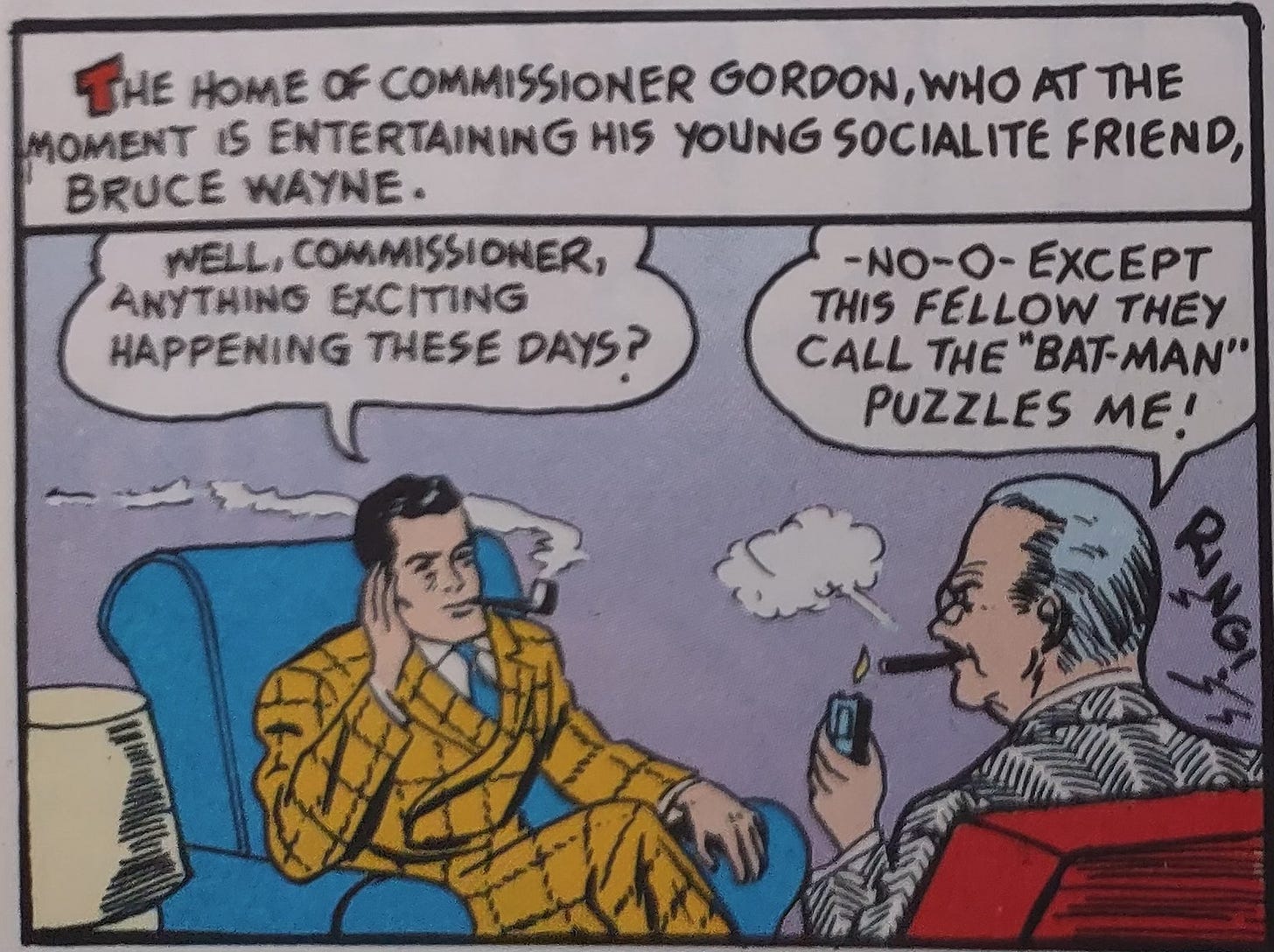
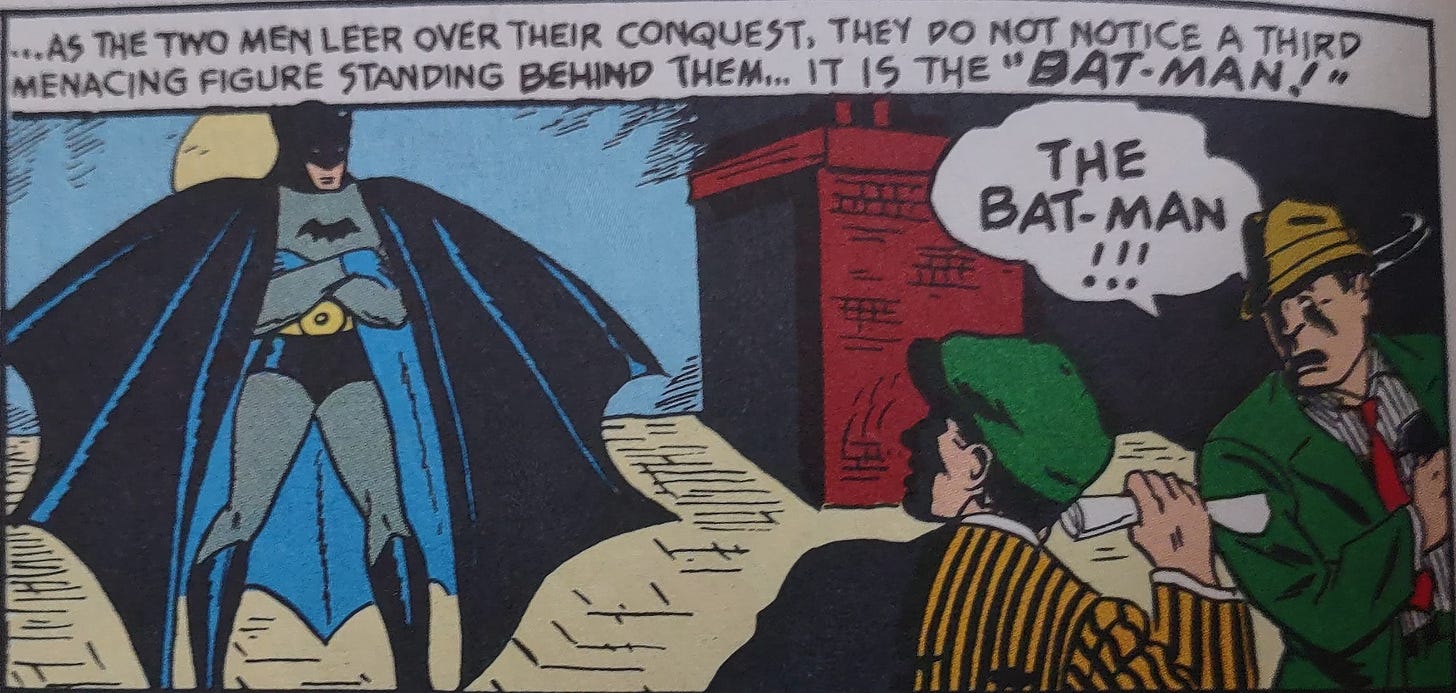
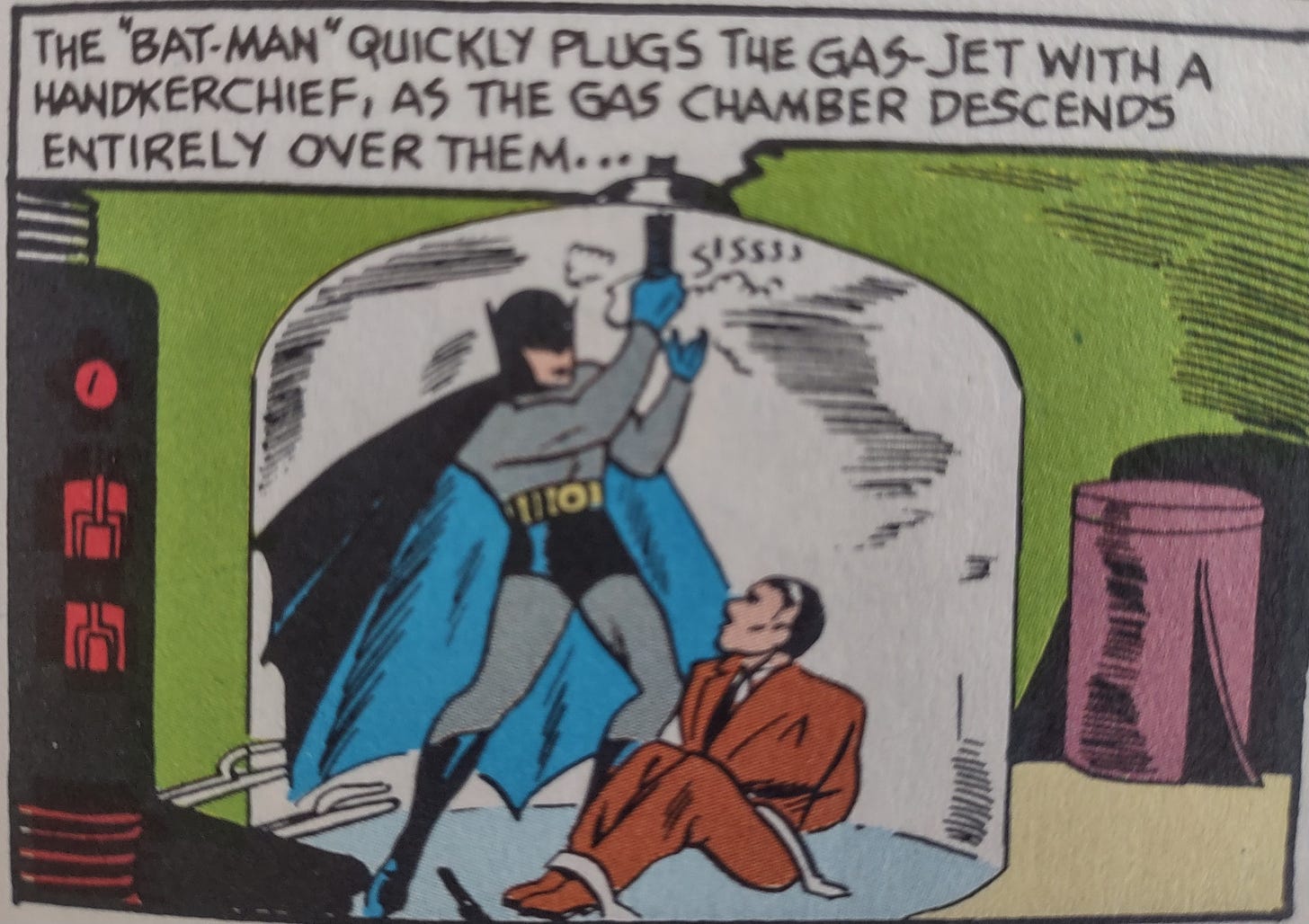
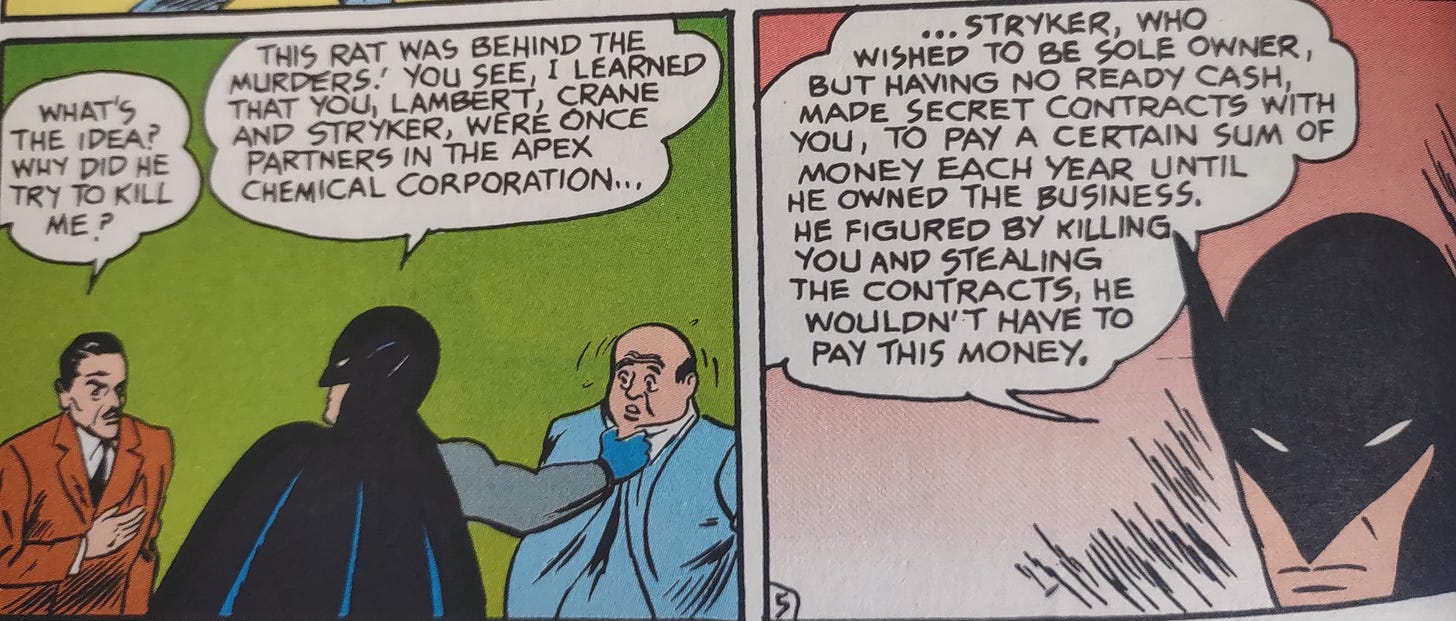
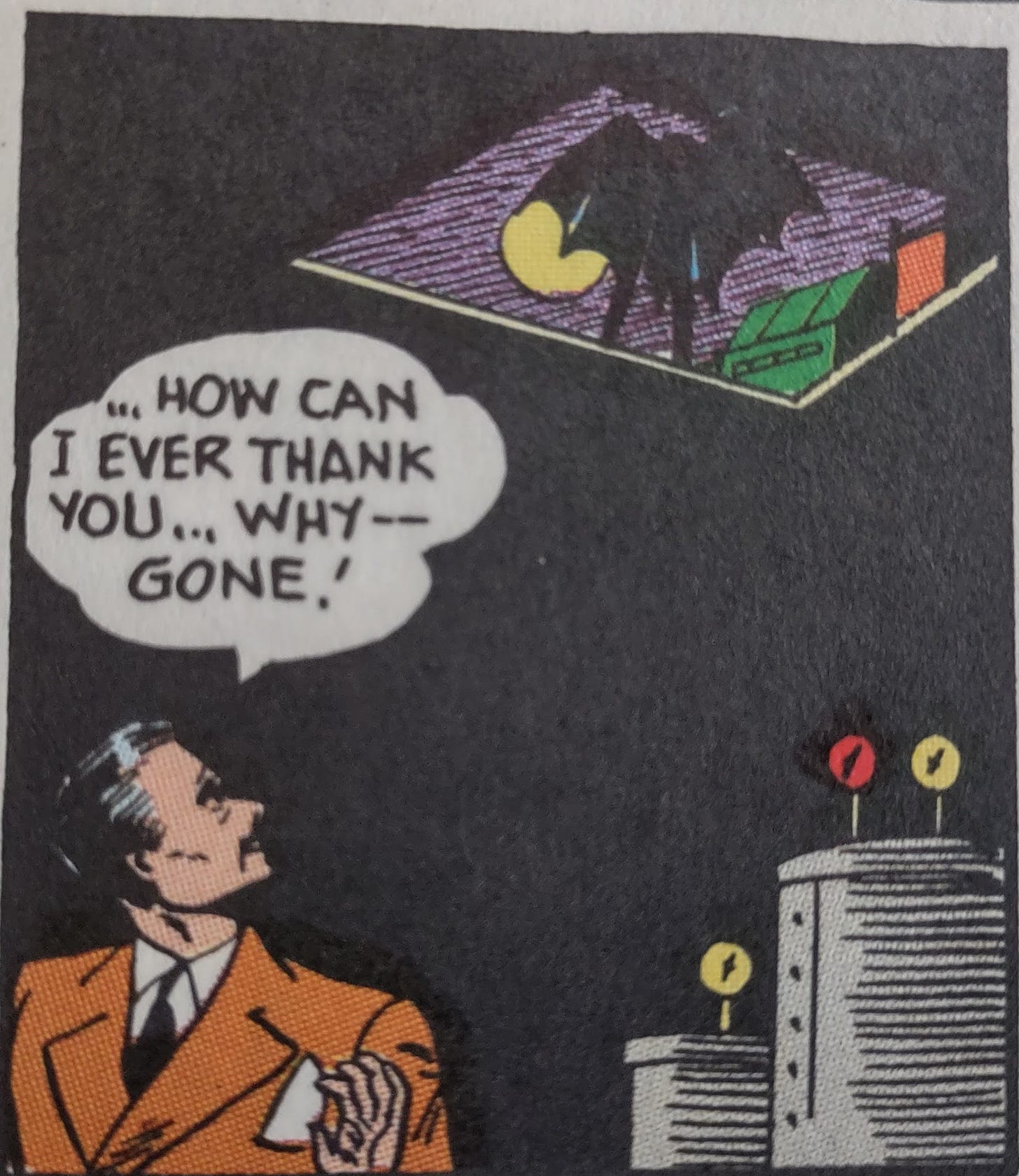
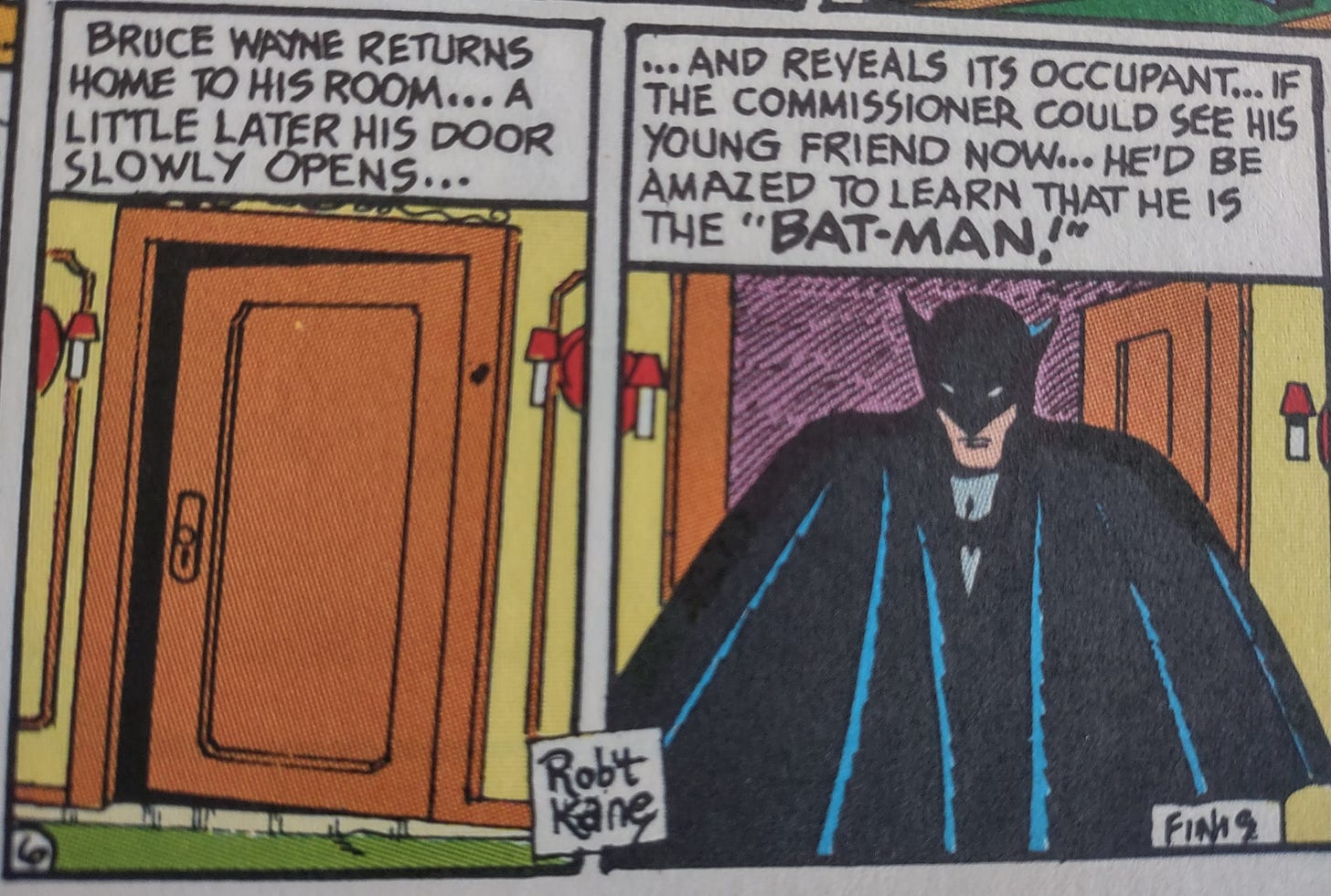
The animated series got the uniform pretty much straight from the comic, it looks like. I'd never seen this before, so this was really fascinating. Nothing about the parents, Crime Alley, the Joker, even the not-killing part; it's just straight up: here's a guy dressed as a bat, and also he's a really good detective, and he's also Bruce Wayne, bored socialite.
Fascinating.
I saw ‘Batman and Bill’ several years ago and it’s a really great documentary. I had no idea Bill Finger contributed so much to the character and to his world. Tragic the way his life went but glad he’s now being recognized. As a kid I had a book about the beginnings and evolution of Batman through the years. Bought it right after Batman premiered in 1989. The book was all about Bob Kane. I don’t remember a single mention of Bill (probably because Bob wrote the book).